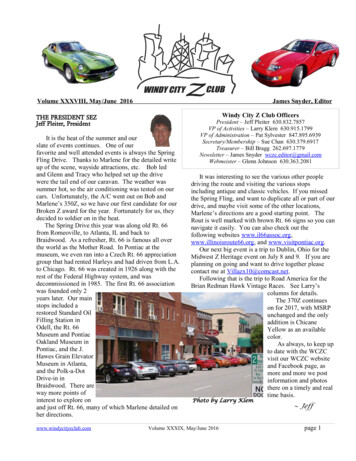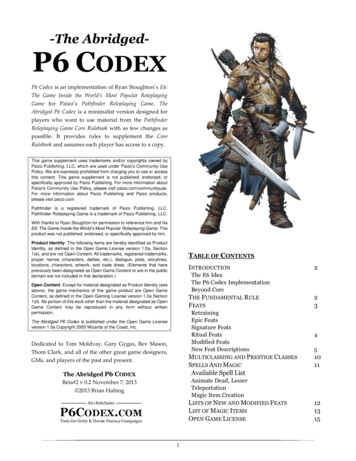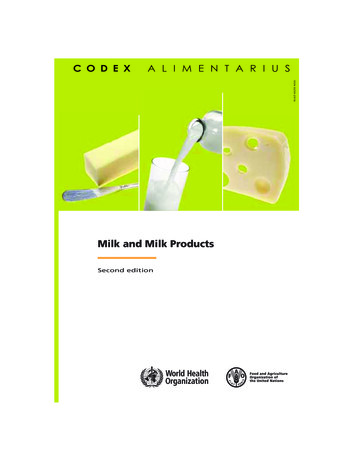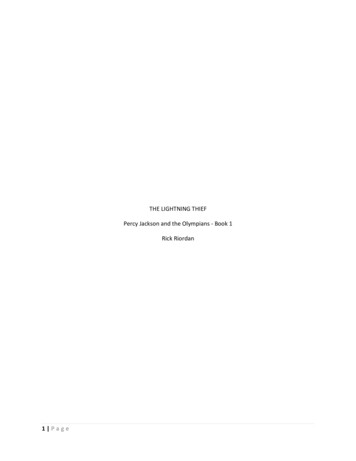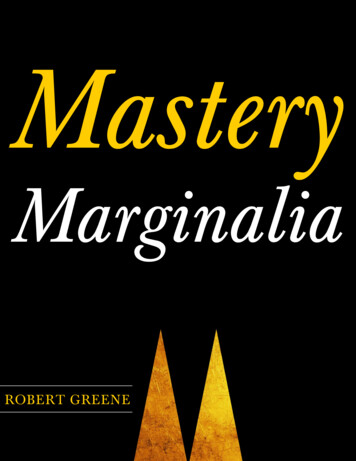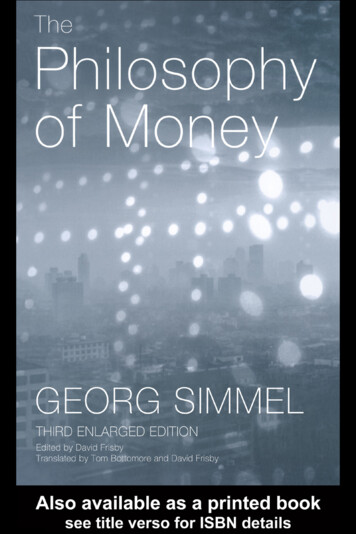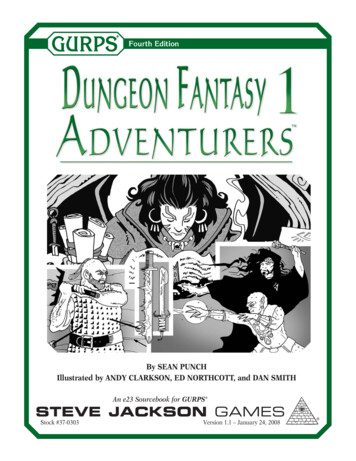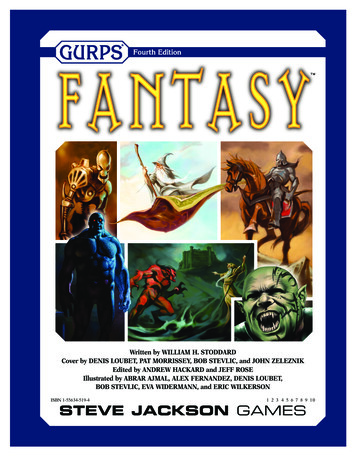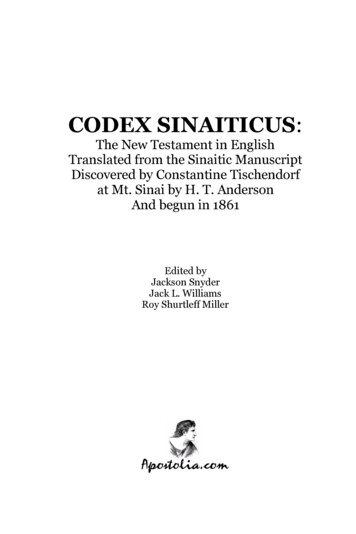
Transcription
CODEX SINAITICUS:The New Testament in EnglishTranslated from the Sinaitic ManuscriptDiscovered by Constantine Tischendorfat Mt. Sinai by H. T. AndersonAnd begun in 1861Edited byJackson SnyderJack L. WilliamsRoy Shurtleff Miller
2Codex Sinaiticus:Codex Sinaiticus:The H. T. Anderson New Testament 2004-2010 Jackson H. Snyder IIAll Rights ReservedISBN 978-0-557-34102-3 HardcoverIn Memory of Roy Shurtleff Miller 1950 - 2009Though we have combed the text for errors, you may findsome. Please report them to Apostolia.com.
The H. T. Anderson New 464488588PrefacesAccording to MatthewAccording to MarkAccording to LukeAccording to JohnActs of the ApostlesActs 29, Sonnini ManuscriptPaul to the RomansPaul to the Corinthians 1stPaul to the Corinthians 2ndPaul to the GalatiansPaul to the EphesiansPaul to the PhilippiansPaul to the ColossiansPaul to the Thessalonians 1stPaul to the Thessalonians 2ndPaul to Timothy 1stPaul to Timothy 2ndPaul to TitusPaul to PhilemonEpistle of HebrewsEpistle of JamesEpistle of Peter 1stEpistle of Peter 2ndEpistle of John 1stEpistle of John 2ndEpistle of John 3rdEpistle of JudeRevelation of Jesus ChristEpistle of BarnabasShepherd of HermasDidachē or Teaching of the Twelve3
4Codex Sinaiticus:Editor’s PrefaceEnglish translations of the Sinaiticus are rare enough; butAnderson’s New Testament is unique. We hope the reader willappreciate the literacy,accuracy and authenticity ofthis work – which was thegoal of the translator’s lifeand the editors’ passion.Anderson did not translateThe Shepherd or Epistle ofBarnabas. The Barnabashere is based on Hoole’s1885 re-edited by TedDornan in 2007. TheLightfoot translation of TheShepherd of Hermas isoffered here to make thecorpus complete. TheSinaitic manuscript ismissing enough pages at the end to account for the inclusion ofThe Didachē or Teaching of the Twelve, which we suspectwould have been close to its companion text, Barnabas. Forgood measure, I added the Sonnini Manuscript, St. Paul inGreat Britain, in the place of Acts 29.(As of 2010, I have new, annotated English translations of theDidachē and Barnabas, each interpaginated with the ReceivedGreek text, available in Hebraic Roots versions atwww.Apostolia.com.)We recommend two books that may be helpful inunderstanding the rightful place of Sinaiticus in the history ofthe canon: Bart Ehrman’s Lost Scriptures: Books That DidNot make It Into the New Testament (2003) andEncountering the Manuscripts: An Introduction to NewTestament Paleography & Textual Criticism, Philip WesleyComfort, (2005).Codex Sinaiticus, from Wikipedia, the free encyclopedia.Codex Sinaiticus is a 4th century uncial manuscript of theGreek Bible, written between 330–350. While it originallycontained the whole of both Testaments, only portions of the
The H. T. Anderson New Testament5Greek Old Testament or Septuagint survive, along with acomplete New Testament, the Epistle of Barnabas, andportions of The Shepherd of Hermas (suggesting that the lattertwo may have been considered part of Biblical canon by theeditors of the codex). Along with Codex Vaticanus, CodexSinaiticus is one of the most valuable manuscripts for textualcriticism of the Greek New Testament, as well as theSeptuagint. For most of the New Testament, Codex Sinaiticusis in general agreement with Codex Vaticanus and CodexEphraemi Rescriptus, attesting an Alexandrian text-type, butin John 1:1-8:38, Codex Sinaiticus is in closer agreement withCodex Bezae in support of a Western text-type. A notableexample of an agreement between the Sinaiticus and Vaticanustexts is that they both omit the phrase “without cause” fromMatthew 5:22.The entire codex consists of 346½ folios, written in fourcolumns. Of these, 199 belong to the Old Testament and 147½belong to the New Testament, along with two other books, theEpistle of Barnabas and part of The Shepherd of Hermas. Thebooks of the New Testament are arranged in this order: thefour Gospels, the epistles of Paul, the Acts of the Apostles, theGeneral Epistles, and the Book of Revelation.Of its prior history, little is known. It is speculated to havebeen written in Egypt and is sometimes associated with the 50copies of the scriptures commissioned by Roman EmperorConstantine after his conversion to Christianity.A paleographical study at the British Museum in 1938 foundthat the text had undergone several corrections. The firstcorrections were done by several scribes before the manuscriptleft the scriptorium. In the sixth or seventh century manyalterations were made, which, according to a colophon at theend of the book of Esdras and Esther states, that the source ofthese alterations was “a very ancient manuscript that had beencorrected by the hand of the holy martyr Pamphylus“(martyred AD 309). From this is concluded, that it had been inCaesarea Maritima in the 6th or 7th centuries. Uncorrected isthe pervasive iotacism, especially of the ει diphthong.The Codex Sinaiticus was shown to Constantin vonTischendorf on his third visit to the Monastery of SaintCatherine, at the foot of Mount Sinai in Egypt, in 1859. Thefirst two trips had yielded parts of the Old Testament, some
6Codex Sinaiticus:found in a basket of manuscript pieces, which Tischendorf wastold by a librarian “were rubbish which was to be destroyed byburning it in the ovens of the monastery.” (However, this storymay have been a fabrication, or the manuscripts in questionmay been unrelated to Codex Sinaiticus: Rev. J. SilvesterDavies in 1863 quoted“a monk of Sinai who . stated that according to the librarianof the monastery the whole of Codex Sinaiticus had been in thelibrary for many years and was marked in the ancientcatalogues . Is it likely . that a manuscript known in thelibrary catalogue would have been jettisoned in the rubbishbasket.”Indeed, it has been noted that the leaves were in “suspiciouslygood condition” for something found in the trash.) Tischendorfhad been sent to search for manuscripts by Russia’s TsarAlexander II, who was convinced there were still manuscriptsto be found at the Sinai monastery. In May 1975, duringrestoration work, the monks of St. Catherine’s monasterydiscovered a room beneath the St. George Chapel whichcontained many parchment fragments. Among thesefragments were twelve missing leaves from the Sinaiticus OldTestament.The story of how von Tischendorf found the manuscript, whichcontained most of the Old Testament and all of the NewTestament, has all the interest of a romance. Von Tischendorfreached the monastery on January 31; but his inquiriesappeared to be fruitless. On February 4, he had resolved toreturn home without having gained his object:On the afternoon of this day I was taking a walk with thesteward of the convent in the neighbourhood, and as wereturned, towards sunset, he begged me to take somerefreshment with him in his cell. Scarcely had he entered theroom, when, resuming our former subject of conversation, hesaid: “And I, too, have read a Septuagint” — i.e. a copy of theGreek translation made by the Seventy. And so saying, he tookdown from the corner of the room a bulky kind of volume,wrapped up in a red cloth, and laid it before me. I unrolled thecover, and discovered, to my great surprise, not only those veryfragments which, fifteen years before, I had taken out of thebasket, but also other parts of the Old Testament, the New
The H. T. Anderson New Testament7Testament complete, and, in addition, the Epistle of Barnabasand a part of the Shepherd of Hermas.After some negotiations, he obtained possession of thisprecious fragment. James Bentley gives an account of how thiscame about, prefacing it with the comment, “Tischendorftherefore now embarked on the remarkable piece of duplicitywhich was to occupy him for the next decade, which involvedthe careful suppression of facts and the systematic denigrationof the monks of Mount Sinai.”[5] He conveyed it to TsarAlexander, who appreciated its importance and had itpublished as nearly as possible in facsimile, so as to exhibitcorrectly the ancient handwriting. The Tsar sent the monastery9,000 rubles by way of compensation.Regarding Tischendorf’s role in the transfer to SaintPetersburg, there are several views. Although when parts ofGenesis and Book of Numbers were later found in the bindingsof other books, they were amicably sent to Tischendorf, thecodex is currently regarded by the monastery as having beenstolen, is a view hotly contested by several scholars in Europe.In a more neutral spirit, New Testament scholar BruceMetzger writes:Certain aspects of the negotiations leading to the transfer ofthe codex to the Czar’s possession are open to aninterpretation that reflects adversely on Tischendorf’s candourand good faith with the monks at St. Catherine’s. For a recentaccount intended to exculpate him of blame, see ErhardLauch’s article ‘Nichts gegen Tischendorf’ in Bekenntnis zurKirche: Festgabe für Ernst Sommerlath zum 70. Geburtstag(Berlin, c. 1961); for an account that includes a hithertounknown receipt given by Tischendorf to the authorities at themonastery promising to return the manuscript from St.Petersburg ‘to the Holy Confraternity of Sinai at its earliestrequest’, see Ihor Ševčenko’s article ‘New Documents onTischendorf and the Codex Sinaiticus’, published in the journalScriptorium, xviii (1964) pp. 55–80.For many decades, the Codex was preserved in the RussianNational Library. In 1933, the Soviet Union sold the codex tothe British Library for 100,000. Visitors in our day reportthat the monks at St. Catherine’s Monastery display the receiptthey received from Tischendorf for the Codex, in a frame thathangs upon the wall.
8Codex Sinaiticus:One theological controversy arising from the content of theCodex Sinaiticus are the different writing styles in the Gospelof Mark, indicating the addition of the Resurrection in adifferent, more informal hand (possibly to an earlier, shorterversion of Mark that finished with the empty Tomb).Present LocationThe codex is now split into four unequal portions: 347 leavesin the British Library in London, 12 leaves and 14 fragments inSt. Catherine’s Monastery of Sinai, 43 leaves in the LeipzigUniversity Library, and fragments of 3 leaves in the RussianNational Library in St Petersburg.In June 2005, a joint project to produce a new digital editionof the manuscript (involving all four holding libraries) and aseries of other studies was announced. This will include theuse of hyperspectral imaging to photograph the manuscripts tolook for hidden information such as erased or faded text. Thisis to be done in cooperation with the British Library. (2010:the project continues iographyBruce M. Metzger, The Text of the New Testament, its Transmission,Corruption and Restoration, Oxford University Press, 1992, p. 46.Skeat, T. C. “The Last Chapter in the History of the Codex Sinaiticus.”Novum Testamentum. Vol. 42, Fasc. 3, Jul., 2000. p. 313Davies words are from a letter published in The Guardian on 27 May1863, as quoted by J.K. Elliott in Codex Sinaiticus and the SimonidesAffair, (Thessaloniki: Patriarchal Institute for Patristic Studies,1982), p. 16; Elliott in turn is quoted by Michael D. Peterson in hisessay “Tischendorf and the Codex Sinaiticus: the Saga Continues”, inThe Church and the Library, ed. Papademetriou and Sopko (Boston:Somerset Hall Press, 2005), p. 77. See also notes 2 and 3, p. 90, inPapademetriou.Constantin von Tischendorf, The Discovery of the SinaiticManuscript, Extract from Constantin von Tischendorf, When WereOur Gospels Written? An Argument by Constantine Tischendorf.With a Narrative of the Discovery of the Sinaitic Manuscript [NewYork: American Tract Society, 1866].James Bentley, Secrets of Mount Sinai (Garden City, NY: Doubleday,1986), p. 95.This entry incorporates text from the public domain Easton’s BibleDictionary, originally published in 1897. The editors accessed thisarticle from Wikipedia October 25, 2007.
The H. T. Anderson New Testament9Henry Tompkins Anderson was born in CarolineCounty, Va., January 27,1812. His parents werenatives of that State andwere of the Baptist faith;however, they were liberalin their views. The earlytraining of young Andersonwas in harmony, in a largemeasure, with the simpleteachings of the Bible. Inhis father’s home the Biblewas a daily textbook, andits teaching had a powerfulinfluence upon the youthfulmind of H. T. Anderson. Atthe age of twenty-one heconfessed his faith in hisLord and was baptized by his elder brother. His brotherhad left the Baptist Church and was only a Christian.Henry T. renewed his prayerful study of the Bible andmade rapid progress in developing his spiritual life. Hebegan to preach in May, 1833, about ten months after hisbaptism.He had a unique method of studying the Scriptures. Heleft nothing without mastering to the best of his abilityevery word and sentence of the New Testament. He hadbeen educated in the best schools of Virginia at that time,and he brought his learning into use in the study of theNew Testament. He began early to study the NewTestament in the original Greek as well as in the English.He became as familiar with the Greek text of the NewTestament as he was with the English text. He neverceased to study the New Testament in Greek.He remained in Virginia and preached in his nativecounty and surrounding counties until 1837, at whichtime he moved to Kentucky, and taught school for anumber of years in Southern Kentucky. He never ceased
10Codex Sinaiticus:to preach the gospel as opportunity was given him. Hepreached much in Christian and Todd counties. In 1841he was invited to come to Nashville, Tenn. He acceptedthe invitation and labored with the congregation inNashville for several months. Part of this time he madehis home with Tolbert Fanning, who lived near Nashville.In 1847 he was called to preach for the Walnut StreetChurch, Louisville, Ky., and continued his work with thatchurch for six years. After leaving the Walnut StreetChurch he resumed his teaching and taught successfullyin various parts of Kentucky.In 1861 he began the translation of the New Testamentfrom the Greek into the English language. He gave thebest part of his life to this work. He levied tribute on all ofthe resources of his classical mind and liberal educationand gave all to the great task of translating the NewTestament. This was the masterpiece of his life’s work. Hesaw from the reading of the Authorized Version that therewas a need for this translation, and with a consecratedheart he dedicated his all to the task. He speaks of hiswork as follows: “The work has been carried on undermany adverse circumstances, but, by the good providenceof God, it has been completed.” He was about three and ahalf years making this translation. After he hadcompleted it he breathed a prayer of thanksgiving to Godfor permitting him to finish the task. He sent histranslation out with this prayer: “May it go forth, underthe divine blessing, to establish and comfort the hearts ofthose who love the truth.” Many scholars havepronounced this translation the best in the Englishlanguage. Certainly it has many merits and is amonument to the love, scholarship, and prayerful work ofa man who loved supremely the word of God. Thebrotherhood has been blessed and the literature of thedisciples of Christ has been enriched by this very valuablecontribution in the field of translation.Henry T. Anderson had a strong mind which was adornedwith classical training. His preaching was not so
The H. T. Anderson New Testament11eloquent, but simple and practical. He was no pulpitorator and laid no claims to such, but he was a teacherboth in the classroom and in the pulpit. He was no loverof money, but was contented with just enough food andraiment to live upon. Oftentimes, like many other faithfulpreachers of the gospel then, he struggled through muchpoverty and suffering. He was very poorly supported bothas a teacher and a preacher. It is thought that thebrotherhood generally did not know of his deep povertyand necessity of the simple things of life. He did notpossess those winning traits of character which drawpeople very close to him. He was kind and gentle to all,but he was a student. He was so absorbed in his studythat he had not time, as he thought, to make and retainfriends. Possibly he saw this weakness, but his love forstudy caused him to neglect the cultivation of the societyof his brethren and sisters. He suffered in povertywithout complaint. He did not censure the church or hisbrethren for his poverty.He believed firmly in the word of God. He trusted in Godto bring all things to Christ for his own glory and thesalvation of his servant. He had firm convictions, and hehad the courage to stand by these convictions. He did notbelieve that a Christian should take vengeance orretaliate. In the prime of his manhood, under the solemnconviction that Christians are not allowed to takevengeance or retaliate, he submitted gracefully to ascourging or whipping from one who had becomeoffended at him. He did not complain, but took thechastisement in the name of the Lord and sufferedmeekly without any effort to strike back. He had completemastery of himself. He had the courage anddetermination to suffer for Christ’s sake.Probably no one had a faith more simple and wonderfulthan did H. T. Anderson. While he was poor with respectto the worldly things of this life, yet he was rich in faithand strong and courageous in his conviction. When hebegan his translation of the New Testament, he had a
12Codex Sinaiticus:large family to support and a very meager salary orincome; yet he believed that the Lord would provide. Inspeaking of his work in translating the New Testament,he said that the Lord did provide and would continue todo so unto the end.H. T. Anderson was a “man of one book.” He studied theChristian religion only; and the Bible, either in Greek orEnglish, was the only book he wanted or would have. Hehad no desire to study other matters. He may have madea mistake in not studying more in a general way, for nearthe close of his life he unfortunately gave utterance tosome undigested metaphysical conclusions which wereheld against him. Many made his conclusions a ground ofcriticism. The enemies of the truth used them as weaponsagainst the truth. If he had given his attention to thestudy of these questions earlier in life, he would not havemade such a blunder, and the enemies would not havehad the occasion to turn much of his good life andteaching into weapons against the truth.He was forced near the close of his life to give his servicesto the government for bread. He accepted a governmentalposition of minor importance and went to Washington,D. C., and labored hard for his meat and bread. This wassad, as he desired to give all of his time to the study of theBible and the teaching of the same to his fellows. He wasstricken with disease and suffered extremely before hisdeath. He died in the city of Washington, September 19,1872. He had a pilgrimage on earth of sixty years, eightmonths, and eight days. He died in the full assurance ofthe Christian faith.Biographical Sketches of Gospel Preachers, H. Leo Boles,GA c.1932 page 165-169. Information with thanks fromScott Harp, www.restoration.com.
The H. T. Anderson New Testament13CODEX SINAITICUS:The H. T. Anderson New Testamentwith the additions ofThe Sonnini ManuscriptThe Letter of BarnabasThe Shepherd of HermasThe Didachē
14Codex Sinaiticus:According to MatthewMatthew 11 The book of the genealogy of Jesus Christ, the son of David, the sonof Abraham.2 Abraham begot Isaac: Isaac begot Jacob: Jacob begot Judah andhis brothers:3 Judah begot Pharez and Zerah of Tamar: Pharez begot Hezron:Hezron begot Ram:4 Ram begot Amminadab: Amminadab begot Nashon: Nashon begotSalmon:5 Salmon begot Boaz of Rahab: Boaz begot Obed of Ruth: Obed begotJesse:6 Jesse begot David the king. David begot Solomon of the wife ofUriah:7 Solomon begot Rehoboam: Rehoboam begot Abijah: Abijah begotAsa:8 Asa begot Jehosaphat: Jehosaphat begot Jehoram: Jehoram begotUzziah:9 Uzziah begot Jotham: Jotham begot Ahaz: Ahaz begot Hezekiah:10 Hezekiah begot Manasseh: Manasseh begot Amon: Amon begotJosiah:11 Josiah begot Jeconiah and his brothers about the time of theremoval to Babylon.12 But after the removal to Babylon, Jeconiah begot Shealtiel:Shealtiel begot Zerubbabel:13 Zerubbabel begot Abihud: Abihud begot Eliakim: Eliakim begotAzor:14 Azor begot Zadoc: Zadoc begot Achim: Achim begot Eliud:15 Eliud begot Eleazar: Eleazar begot Matthan: Matthan begot Jacob:16 Jacob begot Joseph the husband of Mary, of whom was born Jesuswho is called Christ.17 So all the generations from Abraham till David, are fourteengenerations; and from David till the removal to Babylon, are fourteengenerations; and from the removal to Babylon till Christ, are fourteengenerations.18 But the birth of Jesus Christ was thus: After his mother Mary hadbeen betrothed to Joseph, before they came together, she was foundwith child of the Holy Spirit.19 And Joseph her husband, being just and not willing to make heran example, intended to put her away privately.20 But while he thought of these things, behold, an angel of the Lordappeared to him in a dream, saying: Joseph, son of David, fear not to
The H. T. Anderson New Testament15take to thee Mary thy wife; for that which is conceived in her is of theHoly Spirit.21 And she shall bear a son, and thou shalt call his name Jesus; for heshall save his people from their sins.22 And all this was done, that it might be fulfilled that was spoken bythe Lord through the prophet, saying:23 Behold, the virgin shall be with child, and shall bear a son, andthey shall call his name Immanuel, which is, when translated, Godwith us.24 And Joseph arose from his sleep, and did as the angel of the Lordhad commanded him, and took to him his wife; and knew her not tillshe had brought forth a son; and he called his name Jesus.Matthew 21 But after Jesus had been born in Bethlehem of Judea, in the days ofHerod the king, behold, Magi from the east came to Jerusalem,2 saying: Where is he that has been born king of the Jews? For wesaw his star at its rising, and have come to worship him.3 And hearing it, king Herod was alarmed, and all Jerusalem withhim.4 And he assembled all the chief priests and scribes of the people,and inquired of them where the Christ should be born.5 And they said to him: In Bethlehem of Judea; for thus it is writtenby the prophet:6 And thou, Bethlehem, land of Judah, art by no means the leastamong the princes of Judah; for out of thee shall come a Governor,who shall rule my people Israel.7 Then Herod having secretly called the Magi, inquired of themstrictly the time at which the star appeared;8 and sending them to Bethlehem, said: Go, make strict inquiry forthe young child: and when you have found him, bring me word, that Ialso may go and worship him.9 And after hearing the king, they departed; and lo, the star whichthey had seen at its rising, went before them, till it came and stoodover where the young child was.10 And when they saw the star, they rejoiced with very great joy.11 And coming into the house, they saw the young child with Maryhis mother; and falling down they worshipped him; and havingopened their treasures they offered to him gifts, gold, andfrankincense, and myrrh.12 And having been warned in a dream not to return to Herod, theywithdrew into their own country by another way.13 But after they had withdrawn, behold, an angel of the Lordappeared to Joseph in a dream, saying: Arise, and take the young
16Codex Sinaiticus:child and his mother, and flee into Egypt, and be there till I bringthee word; for Herod is about to seek for the young child, to destroyhim.14 And he arose and took the young child and his mother, by night,and withdrew into Egypt,15 and was there till the death of Herod: that it might be fulfilled thatwas spoken by the Lord through the prophet, saying: Out of Egypt Icalled my Son.16 Then Herod, seeing that he had been deceived by the Magi, wasgreatly enraged; and, having sent out, he slew all the male childrenthat were in Bethlehem, and in all its borders, from the age of twoyears and under, according to the time which he had strictly inquiredof the Magi.17 Then was fulfilled that which was spoken through Jeremiah theprophet, saying:18 A voice was heard in Ramah, wailing and great mourning: Rachelweeping for her children; and she would not be comforted becausethey are no more.19 But after Herod had died, behold, an angel of the Lord appeared ina dream to Joseph in Egypt,20 saying: Arise, and take the young child and his mother, and gointo the land of Israel; for they are dead that sought the young child’slife.21 And he arose and took the young child and his mother, and cameinto the land of Israel.22 But hearing that Archelaus reigned in Judea, in place of his fatherHerod, he was afraid to go thither; but being warned in a dream, hewithdrew into the regions of Galilee,23 and came and dwelt in a city called Nazareth, that it might befulfilled that was spoken through the prophets: He shall be called aNazarene.Matthew 31 But in those days came John the Baptist, preaching in thewilderness of Judea,2 saying: Repent, for the kingdom of the heavens is at hand.3 For this is he that was spoken of through Isaiah the prophet,saying: The voice of one crying in the wilderness. Prepare the way ofthe Lord, make his paths straight.4 But the same John had his clothing of camel’s hair, and a girdle ofleather around his loins, and his food was locusts and wild honey.5 Then went out to him Jerusalem, and all Judea, and all the regionround about the Jordan,6 and were baptized by him in the river Jordan, confessing their sins.
The H. T. Anderson New Testament177 But seeing many of the Pharisees and Sadducees coming to hisbaptism, he said to them: Brood of vipers, who warned you to fleefrom the coming wrath?8 Bring forth therefore fruit worthy of repentance,9 and think not to say within yourselves: We have Abraham for afather; for I say to you that God is able of these stones to raise upchildren for Abraham.10 And now the ax is lying at the root of the trees: every tree,therefore, that brings not forth good fruit is cut down, and throwninto the fire.11 I indeed baptize you in water in order to repentance; but he thatcomes after me is mightier than I, whose sandals I am not worthy tocarry: he will baptize you in the Holy Spirit and in fire:12 whose winnowing shovel is in his hand, and he will thoroughlycleanse his threshing floor, and gather his grain into the granary; butthe chaff he will burn up with unquenchable fire.13 Then came Jesus from Galilee to the Jordan to John, to bebaptized by him.14 But he forbade him, saying: I have need to be baptized by thee,and comest thou to me?15 But Jesus answered and said to him: Permit it now; for thus itbecomes us to fulfill every righteous act. Then he permitted him.16 And having been baptized, Jesus immediately went up from thewater; and lo, the heavens were opened, and he saw the Spirit of Goddescending like a dove and coming upon him.17 And lo, a voice from the heavens, saying: This is my beloved Son,in whom I am well pleased.Matthew 41 Then was Jesus led up by the Spirit into the wilderness, to betempted by the devil.2 And having fasted forty days and forty nights, he was afterwardhungry.3 And the tempter came and said to him: If thou art the Son of God,command that these stones become bread.4 But he answered and said: It is written: Not by bread alone shallman live, but by every word that comes forth through the mouth ofGod.5 Then the devil took him into the holy city, and set him on the wingof the temple.6 and said to him: If thou art the Son of God, cast thyself down; for itis written: He will give his angels charge concerning thee, and intheir hands they shall take thee up, lest thou strike thy foot against astone.
18Codex Sinaiticus:7 Jesus said to him: Again it is written: Thou shalt not put the Lordthy God to the proof.8 Again, the devil took him to a very high mountain, and showed himall the kingdoms of the world, and the glory of them,9 and said to him: All these will I give thee, if thou wilt fall down andworship me.10 Then Jesus says to him: Get hence, Satan; for it is written: TheLord thy God thou shalt worship, and him only shalt thou serve11 Then the devil left him; and, behold, angels came and ministeredto him.12 But when he had heard that John was delivered up, he withdrewinto Galilee;13 and leaving Nazareth, he came and dwelt in Capernaum, which ison the sea, in the borders of Zebulon and Naphtali;14 that it might be fulfilled that was spoken through Isaiah theprophet, saying:15 The land of Zebulon, and the land of Naphtali, toward the sea,beyond the Jordan, Galilee of the Gentiles;16 the people that sat in darkness saw great light; and upon thosewho sat in the region and shadow of death light arose.17 From that time Jesus began to preach and to say: Repent, for thekingdom of the heavens is at hand.18 And walking by the sea of Galilee, he saw two brothers, Simonwho is called Peter, and Andrew his brother, throwing a net into thesea, for they were fishers.19 And he said to them: Come after me, and I will make you fishers ofmen.20 And they immediately left their nets and followed him.21 And going on thence, he saw other two brothers, James the son ofZebedee, and John his brother, in the ship with Zebedee their father,mending their nets; and he called them.22 And immediately leaving the ship and their father, they followedhim.23 And he went about in the whole of Galilee, teaching in theirsynagogues, and preaching the gospel of the kingdom, and curingevery disease and every malady among the people.24 And his fame went abroad into the whole of Syria; and the
Not make It Into the New Testament (2003) and Encountering the Manuscripts: An Introduction to New Testament Paleography & Textual Criticism, Philip Wesley Comfort, (2005). Codex Sinaiticus, from Wikipedia, the free encyclopedia. Codex Sinaiticus is a 4th century uncial manuscript of the Greek Bib
